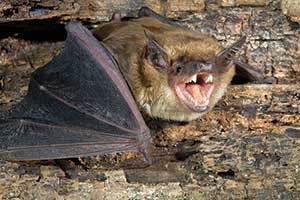
Don’t assume bats enter structures only at the eaves or peaks. Sometimes, they enter as low as 18 in. from the ground. Photo: ©istock.com/ivkuzmin
Many homeowners are afraid of bats, so it’s important to effectively control these animals. Following are 10 tips to help you better manage bats.
1. Don’t confuse mouse droppings with bat droppings. Bat droppings:
⦁ collect in piles below where bats roost or exit a structure,
⦁ appear speckled from the fragments of undigested exoskeletons of insects, and
⦁ crumble easily when dry.
2. Require technicians to wear properly fitted respirators with filters rated N100 or higher before they enter an attic or crawlspace.
3. Bat droppings can directly transmit the fungal spores that cause histoplasmosis. Active roosts can infect workers even when an attic is hot and dry.
4. Workers exposed to environments contaminated with bat droppings should be familiar with, and follow, the information contained in the U.S. Centers for Disease Control and Prevention (CDC) document “Histoplasmosis-Protecting Workers at Risk” (NIOSH number 2005-109). It can be found online at CDC.gov/niosh/docs/2005-109.
5. Carry printed copies of the rabies protocols in your state, and require technicians to provide a copy to each customer with potential or actual bat problems. Technicians should have clients sign that they received the information. Under no circumstances should technicians provide a diagnosis. For more, see page 16 of the PDF found at DHHS.nh.gov/dphs/cdcs/rabies/documents/providerguide.pdf.
6. Never release a bat captured from the home’s living space, where it could have had contact with people, unless the potential for rabies exposure has been eliminated conclusively.
7. Don’t assume a sleeping customer would know whether he or she was bitten by a bat.
8. Obtain the contact and emergency numbers, and the submission process for shipping bats for rabies testing, before there’s an incident.
9. Perform detailed bat inspections. Don’t assume bats enter structures only at the eaves or peaks. Sometimes they enter as low as 18 in. from the ground.
10. Discard or wash bat excluders with a 10 percent bleach solution after each use to prevent the spread of the fungus that causes white-nose syndrome (WNS).
You can reach Dr. Stephen Vantassel at stephenvantassel@hotmail.com. Check out his blog at WildlifeControlConsultant.com.
Leave A Comment